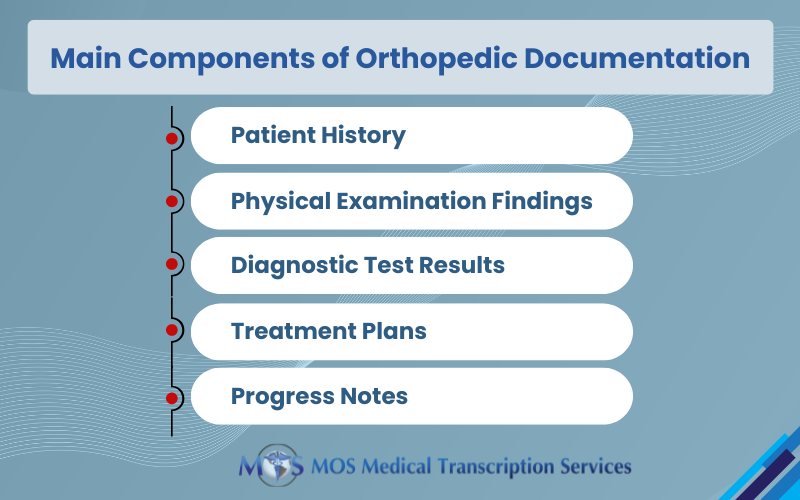
Table of Contents
Orthopedic documentation plays a pivotal role in capturing the intricate details of patient care, diagnosis, and treatment. From fractures and joint replacements to spinal surgeries and sports injuries, accurate and comprehensive documentation is essential for ensuring optimal patient outcomes. Medical transcription services ensure accurate and clear documentation of orthopedic encounters by transcribing dictations, voice recordings, and handwritten notes into structured and organized medical records, facilitating effective communication among healthcare providers.
Understanding Orthopedic Documentation
Orthopedic medicine focuses on restoring normal function to the skeletal system, particularly the spine, limbs, and other tissues like muscles and ligaments. Maintaining meticulous records of every aspect of a patient’s care is crucial. Precise and timely orthopedic medical transcription is essential to preserve the accuracy and dependability of data in a variety of domains, from patient care to legal matters and scientific research.
Orthopedic documentation serves many purposes:
- Enhances Patient Care: Proper record-keeping ensures that all healthcare providers involved in a patient’s care have access to complete and up-to-date information. This promotes better patient outcomes and knowledgeable decision-making.
- Legal and Regulatory Compliance: Accurate documentation is essential to uphold compliance with healthcare standards and regulations. Thorough record-keeping provides vital protection in the event of a malpractice investigation.
- Facilitates Smooth Communication: Electronic health record documentation facilitates more efficient communication between various healthcare professionals, including nurses, orthopedic surgeons, physical therapists, and primary care physicians.
- Billing and Insurance: Accurate documentation is required for billing and insurance claims. It offers evidence of the medical necessity and efficacy of treatment provided.
- Education and Research: By providing details on procedures and outcomes, documentation aids in orthopedic medical research. It serves as a teaching tool for students as well as medical professionals.
Essential Components of Orthopedic Documentation

Legal compliance, effective provider-to-provider communication, and high-quality patient treatment all depend on appropriate orthopedic documentation. The following elements must be present in sufficient orthopedic documentation, along with an explanation of each:
- Patient History: Precise diagnosis and treatment planning are predicated on a thorough patient history. It consists of:
- Prior Injuries and Surgery: Information regarding prior musculoskeletal trauma or surgical procedures can shed light on present ailments and possible side effects.
- Family medical history: Details regarding inherited propensities for arthritis or osteoporosis.
- Lifestyle Factors: Sports involvement, occupation, and activity level can all have an impact on musculoskeletal health.
- Impact: Assists in anticipating possible hazards or issues and understanding the context of the existing scenario.
- Physical Examination Findings
- Keeping track of symptoms such as pain, stiffness, or discomfort that patients describe.
- Measuring and recording the afflicted joints’ or limbs’ range of motion.
- Observations about muscle strength, deformities, edema, and other physical characteristics.
These results direct the diagnostic procedure and aid in creating a treatment strategy.
- Diagnostic Test Results
- Thorough documentation of X-ray, MRI, CT, and other pertinent test results.
- Understanding the amount and kind of the injury or ailment requires analysis and interpretation of these data.
- Vital for precise diagnosis and tracking the development or recovery of musculoskeletal problems.
- Treatment Plans
- Documenting suggested treatment modalities, including as post-operative care, surgical techniques, and non-surgical therapies.
- To guarantee the best possible recovery, comprehensive programs for physical therapy and rehabilitation are required.
- Guarantees a methodical approach to healing and rehabilitation, resulting in improved results.
- Progress Notes
- Regular reports on the patient’s condition of recovery, reaction to therapy, and alterations in symptoms.
- A record of the patient’s reaction to the medication, including any side effects or issues.
- Keeping track of any difficulties or unanticipated results while receiving treatment.
- Essential for maintaining patient care and modifying treatment plans as needed.
Major Challenges in Orthopedic Documentation
Despite its importance, orthopedic documentation frequently encounters problems that can reduce its efficacy and efficiency. Maintaining high standards for patient care and documentation quality depends on addressing these issues. Here are a few of the primary documentation challenges that orthopedists experience:
- Time Limitations: Healthcare workers often have busy schedules, so it can be difficult to set aside enough time for careful recordkeeping. It can be challenging to strike a balance between the deadlines and the needs for thorough documentation. Inadequate or hurried documentation might result in mistakes, misunderstandings, and possibly worse patient care.
- Staying Current with Technological Developments: The rapid advancement of medical and documentation technologies necessitates ongoing education and adjustment. Updating one’s knowledge and skills to use the newest tools and software can be intimidating at times and take a lot of effort. Underutilization of resources and ineffective documentation processes might arise from a failure to stay up to date with technology.
- Assuring Multidisciplinary Communication: Orthopedic care typically involves a team of medical professionals, and effective communication is essential to the coordination of care, ensuring that all pertinent data is accurately and quickly shared throughout all disciplines. Poor communication can lead to delayed treatment, repeated testing, disorganized care, and a higher risk of errors.
How Medical Transcription Services Ensure Proper Orthopedic Documentation
- Accuracy and Clarity: Medical transcription services ensure accurate and clear documentation of orthopedic encounters by transcribing dictations, voice recordings, and handwritten notes into structured and organized medical records. Professional transcribers with expertise in orthopedic terminology and procedures deliver error-free transcripts that reflect the nuances of orthopedic documentation.
- Timeliness and Efficiency: Outsourcing orthopedic transcription to an experienced service provider ensures timely turnaround times, allowing healthcare providers to access updated patient records promptly. This is crucial for maintaining continuity of care, facilitating interdisciplinary communication, and meeting regulatory requirements for documentation timelines.
- Compliance and Coding Support: Transcription services assist orthopedic practices in maintaining compliance with regulatory standards, documentation guidelines, and coding requirements. This helps ensure proper reimbursement, reduced claim denials, and streamlined revenue cycle management.
- Focus on Patient Care: By alleviating the burden of documentation tasks, medical transcription services enable orthopedic specialists to focus on patient care, clinical decision-making, and quality improvement initiatives. Enhanced workflow efficiency and reduced administrative burdens contribute to improved provider satisfaction and patient outcomes.
To learn more about the benefits of hiring a medical transcription service for your orthopedic practice, read: What Are The Benefits Of A Specialty-Specific EHR For Orthopedic Practices
Orthopedic documentation encompasses a comprehensive set of components that are vital for delivering high-quality patient care, ensuring accurate diagnosis and treatment, and supporting effective communication among healthcare providers. Medical transcription services play a crucial role in enhancing orthopedic documentation processes by offering accuracy, timeliness, compliance, and coding support. By leveraging professional transcription services, orthopedic practices can optimize their documentation workflows and prioritize patient-centered care.
